NCERT Solutions for Class 11 Biology Chapter 13 Photosynthesis
These Solutions are part of NCERT Solutions for Class 11 Biology. Here we have given NCERT Solutions for Class 11 Biology Chapter 13 Photosynthesis.
Question 1.
By looking at a plant externally can you tell whether a plant is C3 or C4 ? Why and how?
Solution:
Plants that are adapted to dry tropical regions have the C4 pathway. They have a special type of leaf anatomy, they tolerate higher temperatures, they show a response to highlight intensities. Study vertical sections of leaves, one of a C3 plant and the other of a C4 plant.
Question 2.
By looking at which internal structure of a plant can you tell whether a plant is C3 or C4? Explain.
Solution:
In C4 plant internal structure of the leaf possess a special type of anatomy called ‘Kranz’ anatomy. ‘Kranz’ means ‘wreath’ and is a reflection of the arrangement of cells.
The bundle sheath cells may form several layers around the vascular bundles; they are characterised by having large number of chloroplasts, thick walls impervious to gaseous exchange and no intercellular spaces.
While in C3 plants, there is no special type of leaf anatomy. There is only a single type of chloroplast inC3 i.e. granal, while in C4 chloroplasts are dimorphic, i.e, granite in the mesophyll cells and agranal in the bundle sheath cells.
Question 3.
Even though very few cells in a C4 plant carry out the biosynthetic-Calvin pathway, yet they are highly productive, can you discuss why?
Solution:
Though these plants have the C4 oxalacetic acid as the first CO2 fixation product they use the C3 pathway or the Calvin cycle as the main biosynthetic pathway.
In C4 plants photorespiration does not occur. This is because they have a mechanism that increases the concentration of CO2 at the enzyme site.
This takes place when the C4 acid from the mesophyll is broken down in the bundle cells to release CO2 this results in increasing the intracellular concentration of CO2 In turn, this ensures that the Rubisco functions as a carboxylase minimizing the oxygenase activity.
Now that you know that the C4 plants lack photorespiration, you probably can understand why productivity and yields are better in these plants. In addition, these plants show tolerance to higher temperatures.
Question 4.
RuBisCO is an enzyme that acts both as carboxylase and oxygenase. Why do you think RuBisCO carries out more carboxylation in C4 plants.
Solution:
RuBisCO or Ribulose bisphosphate carboxylase – oxygenase enzyme can bind to both C02 and O2. This binding is competitive. The relative concentration of C02 and 02 determines which one of the two will bind to the enzyme.
In C4 plants photorespiration does not occur. This is because they have a mechanism that increases the concentration of C02 at the enzyme site.
This takes place when oxaloacetic acid is broken down in the bundle sheath cells to release C02.
It results in increased intracellular concentration of C02. This ensures that the RuBisCO functions as a carboxylase and minimising the oxygenase activity.
Question 5.
Suppose there were plants that had a high concentration of chlorophyll b, but lacked chlorophyll a, would it carry out photosynthesis? Then why do plants have chlorophyll b and other accessory pigments?
Solution:
Though chlorophyll is the major pigment responsible for trapping light, other thylakoid pigments like chlorophyll b, xanthophylls, and carotenoids, which are called accessory pigments, also absorb light and transfer the energy to ‘chlorophyll a’.
Indeed, they not only enable a wider range of wavelengths of incoming light to be utilized for photosynthesis but also protect ‘chlorophyll a’ from photo-oxidation. Reaction centre chlorophyll-protein complexes are capable of directly absorbing light and performing charge separation events without other chlorophyll pigments but the absorption cross-section is small.
Question 6.
Why is the colour of a leaf kept in the dark frequently yellow, or pale green? Which pigment do you think is more stable?
Solution:
Chlorophyll is unable to absorb energy in the absence of light and loses its stability, giving the leaf a yellowish colour. This shows that xanthophyll is more stable.
Question 7.
Look at leaves of the same plant on the shady side and compare it with the leaves on the sunny side. Or, compare the potted plants kept in the sunlight with those in the shade. Which of them has leaves that are darker green? Why?
Solution:
Light is a limiting factor for photosynthesis Leaves get lesser light for photosynthesis when they are in shade. Therefore, the leaves or plants in shade perform lesser photosynthesis as compared to the leaves or plants kept in sunlight. In order to increase the rate of photosynthesis, the leaves present in shade have more chlorophyll pigments.
This increase in chlorophyll content increases the amount of light absorbed by the leaves, which in turn increases the rate of photosynthesis. Therefore, the leaves or plants in shade are greener than the leaves or plants kept in the sun.
Question 8.
The figure shows the effect of light on the rate of photosynthesis. Based on the graph, answer the following questions.
(a) At which point/s (A, B, or C) in the curve is light a limiting factor?
(b) What could be the Jimiting factor/s in region A?
(c) What do C and D represent on the curve?
Solution:
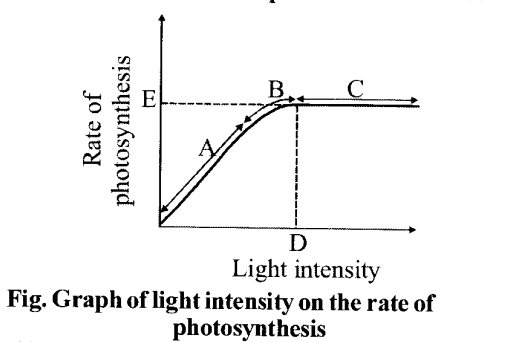
(a) In the region ‘A’ and half of ‘BTight is limiting factor because rate of photosynthesis is increasing with the intensity of light.
(b) All the other factors except light.
(c) C represents a region where a factor other than light is limiting, e.g., CO2. D represents the light intensity at which rate of photosynthesis is maximum under existing conditions (e.g., CO2).
Question 9.
Give a comparison between the following:
(a) C3 and C4 pathways
(b) Cyclic and non-cyclic photophosphorylation
(c) Anatomy of leaf in C3 and C4.
Solution:
(a) Differences between C3 and C4 pathway
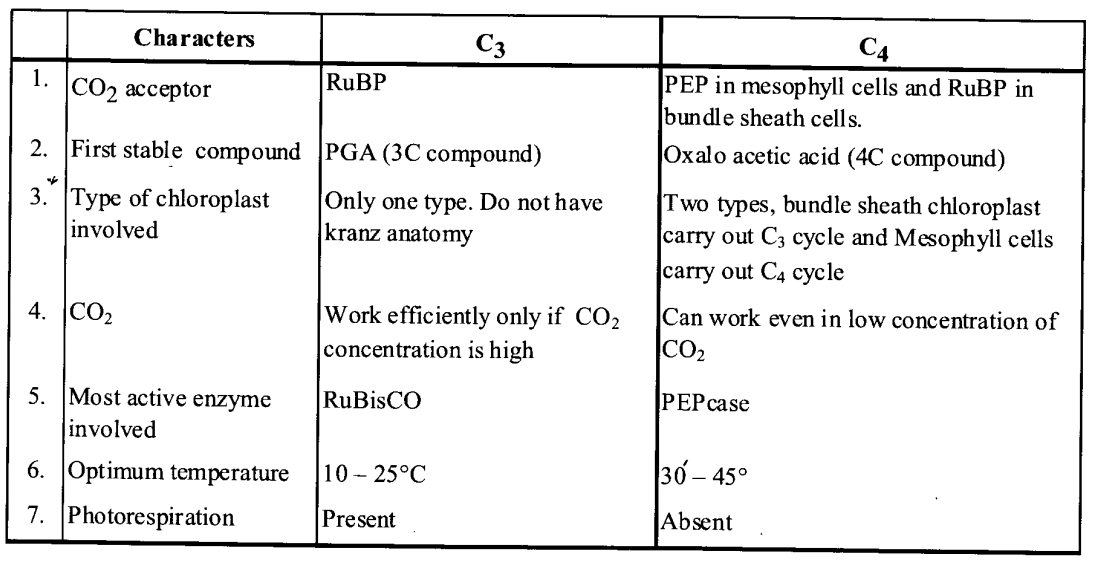
(b) Differences between cyclic and non-cyclic photophosphorylation are
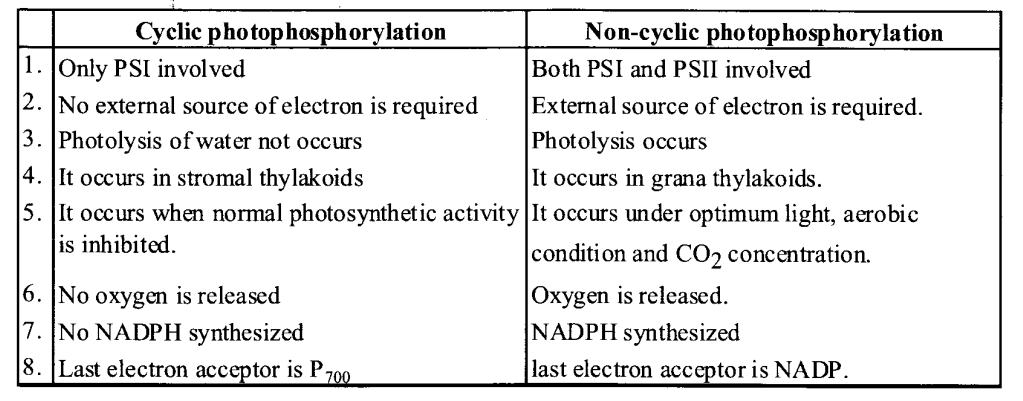
(c) Differences between the anatomy of leaf in C3 plants and anatomy of leaf in C4 plants are
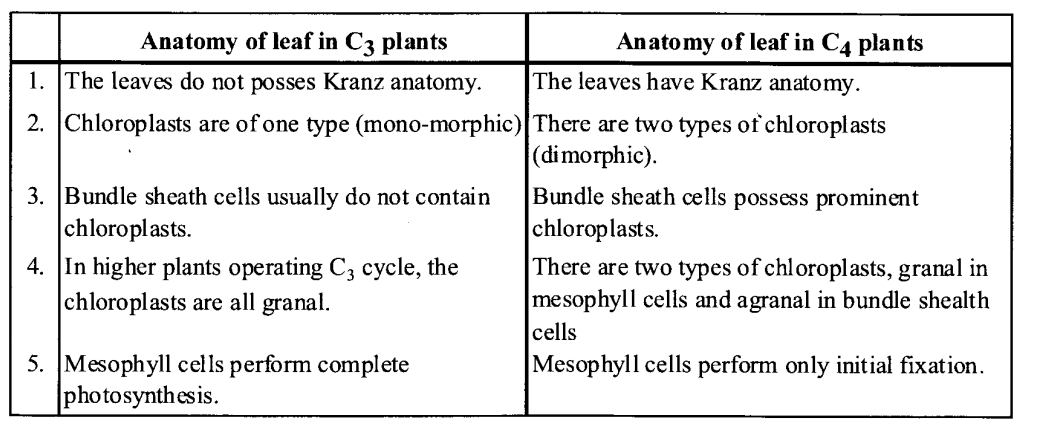
VERY SHORT ANSWER QUESTIONS
Question 1.
Write one anatomical feature of C4 plants.
Solution:
Kranz anatomy in leaf.
Question 2.
Which of the following is not a useful function of the light reaction in photosynthesis?
(a) splitting water
(b) synthesis of NADPH
(c) converting light energy into chemical energy
(d) releasing oxygen for photorespiration
Solution:
(d) Releasing oxygen for photorespiration.
Question 3.
What is the starting substance in the CO2 fixation cycle? (Apr. 91)
Solution:
RuMP.
Question 4.
Where is PS II located in a chloroplast?
Solution:
PS II is located in the appressed regions of grana thylakoid
Question 5.
Name the reaction centre of PS I and PS II.
Solution:
P700 & P680‘
Question 6.
What type of light causes maximum photo-synthesis? (Oct. 1995)
Solution:
Red light
Question 7.
How many molecules of ATP and how many molecules of NADPH are spent to fix three molecules of CO2 in the Calvin cycle?
Solution:
9 ATP and 6 NADPH
Question 8.
Why do the stomata of CAM plants open during the night?
Solution:
As these plants grow in dry areas, they keep stomata close during the day to conserve water and open their stomata during the night for the diffusion of gases.
Question 9.
Mention one useful role of photorespiration in plants.
Solution:
It protects the plants from photooxidative damage.
Question 10.
Cyanobacteria and some other photosynthetic bacteria don’t have chloroplasts. How do they conduct photosynthesis?
Solution:
Cyanobacteria have bluish pigment phycocyanin, which they use to capture light for photosynthesis. Some green bacteria (cyanobacteria) are red or pink due to pigment phycoerythrin. Whatever the colour of cyanobacteria, they are photosynthetic and so can manufacture food.
Question 11.
What is phosphorylation? (M.Q.P.)
Solution:
Synthesis of ATP either with the help of light (during photosynthesis) or in presence of oxygen (during respiration) is called phosphorylation.
Question 12.
Name the organism Englemann used in his experiment.
Solution:
Cladophora.
Question 13.
Write the currently accepted equation of photosynthesis in plants.
Solution:

Question 14.
What is a pigment?
Solution:
A pigment is a substance that absorbs light of certain wavelength(s).
Question 15.
Write the full form of NADP
Solution:
NADP – Nicotinamide adenine dinucleotide Phosphate.
Question 16.
Expand RuBP
Solution:
Ribulose 1, 5 bisphosphates.
Question 17.
Give a reason for the following:
Some bacteria exhibit photosynthesis but they do not produce oxygen. (July 2006)
Solution:
Some photosynthetic bacteria do not use water as their source of hydrogen, hence do not liberate oxygen.
Question 18.
Mention two conditions where light can become a limiting factor.
Solution:
Conditions in which light can become a limiting factor:
(i) Plants in the shade.
(ii) Plants growing under the canopy in a dense forest.
Question 19.
What are antenna molecules?
Solution:
Antenna molecules are light-harvesting pigment molecules that occur on the outer side of a photosynthetic unit.
Question 20.
What is a quantasome? Where is it present?
Solution:
Quantasome means photosynthetic units. It is equivalent is 230 chlorophyll molecules. These are present in the grana lamellae.
SHORT ANSWER QUESTIONS
Question 1.
Specify how C4 photosynthetic pathway increases carbon dioxide concentration in bundle sheath cells of sugarcane?
Solution:
In C4 pathway of sugarcane, C02 from atmosphere enters through the stomata in the mesophyll cell and combines with phosphoenol pyruvate to form a 4-C compound oxaloacetic acid. The OAA is then transported to the bundle sheath where it is decarboxylatedto release C02 in bundle sheath.
Question 2.
Differentiate between absorption spectrum and action spectrum.
Solution:
The main differences between absorption spectrum and action spectrum are as follows.
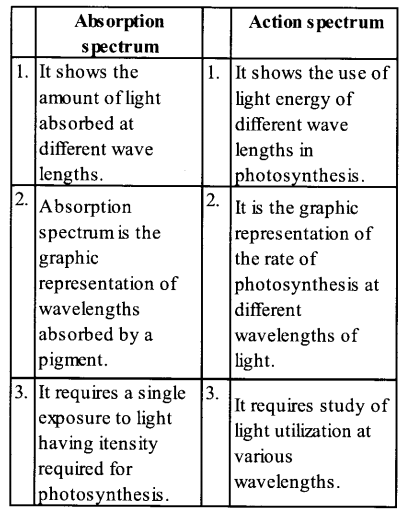
Question 3.
What are quantasomes? (Oct. 94)
Solution:
Quantasome is a functional unit (Photo-synthetic unit) made of a group of pigment molecules required for carrying out a photochemical reaction. The Pigment molecules are embedded in the grana and differentiated as pigment system I (with chi 670, chi 680, P 700) and pigment system ll(with chi 670, chi 680, P 680, and Xanthophylls)
Question 4.
Distinguish between cyclic and non-cyclic photophosphorylation. (M.Q.P., March 2011)
Solution:
Non cyclic photophosphorylation (a) Cyclic photophosphorylation
- The path traversed by an electron is non-cyclic.
(a) Path traversed by electron is cyclic. - Both PSI and PSII are active.
(b) Only PSI is active. - It is accompanied by photolysis.
(c) No photolysis. - The major pathway that takes place.
(d) Secondary pathway when additional ATP is needed.
Question 5.
What is Blackman’s law of limiting factors?
Solution:
F.F. Blackman (1905) extended a law to formulate the principle of limiting factors. “When a process is conditioned as to its rapidity by a number of separate factors, the rate of the process is limited by the pace of slowest factors.”
Question 6.
In the condition of water stress why the rate of photosynthesis declines?
Solution:
Due to water stress, stomata remain closed and so there is a decrease in CO2concentration and the leaf water potential is also reduced, decline the rate of photosynthesis.
Question 7.
What is a reaction centre? Give the reaction centres of PSI and PSII.
Solution:
Reaction centre is a chlorophyll component of the photosystem and it absorbs as well as accepts energy from other pigments and ejects an electron. The reaction centre of PSII is Chla680 or P680 and PSI is Chla700 or P700
Question 8.
Why is photorespiration considered a wasteful process?
Solution:
Photorespiration considered a wasteful process because
(i) 25% of photosynthetically fixed carbon is lost in the form of C02.
(ii) There is no energy-rich useful compound produced during this process.
Question 9.
Give two reasons as to why photosynthesis is important for sustaining life on earth.
Solution:
Photosynthesis is the most important process because;
(i) it is the only natural process by which oxygen is liberated into the atmosphere.
(ii) it is the process by which food is manufactured for all living organisms.
Question 10.
Why does the rate of photosynthesis decrease at higher light intensities? What plays a protective role in such situations?
Solution:
Rate of photosynthesis decreases for two reasons :
(i) Other factors required for photosynthesis become limiting.
(ii) Destruction of chlorophyll by photo-oxidation.
Carotenoids play a protective role by:
(i) absorbing the excess light and
(ii) acting as an antioxidant to detoxify the effect of activated oxygen species.
Question 11.
What is C4 -pathway? Give an example. (March 2008)
Solution:
CA -pathway is an alternative photosynthetic pathway seen in plants like sugarcane/sorghum/ maize in which the stable compound is oxaloacetate a 4-C compound. It is called the Hatch-slack pathway.
Question 12.
What is kranz anatomy in plants?
Solution:
In Kranz Anatomy vascular bundles are surrounded by a layer of bundle sheath that contains a large number of chloroplasts in mesophyll cells and it is present in C4 plants e.g, Maize, Sugarcane, etc.
LONG ANSWER QUESTIONS
Question 1.
How is photosystem I different from photosystem II?
Solution:
The main differences between photosystem I and photosystem II are
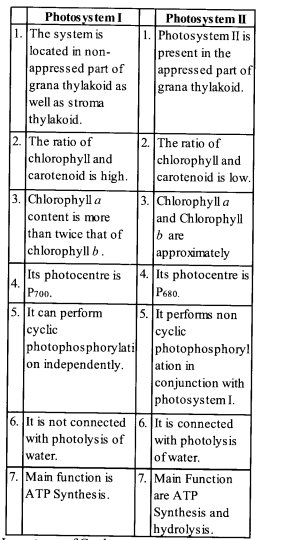
Question 2.
Describe the factors that influence the rate of Photosynthesis. (Oct. 1989)
Solution:
The factors that affect photosynthesis may be both internal & External.
Internal factors:
- Chlorophyll: it is the light-absorbing pigment and only portions of the plant having chlorophyll can help in photosynthesis.
- Protoplasmic factor: young seedlings when transferred from darkness to light show the presence of some factors which is believed to be enzymatic initiates photosynthesis and is called the protoplasmic factor.
External factors:
- Light: It is one of the most important factors which affects the process in 3 ways i.e. quantity, quality, and intensity. Quantity of light is otherwise duration and depends upon the photoperiod that is required by the plant quality refers to the wavelength, maximum photosynthesis occurs in red and blue light while minimum in green light. Intensity favours the process and low intensity decreases the rate of photosynthesis. Very high intensity brings about photooxidation of pigments which is called solarization.
- CO2: An increase in CO2 concentration favours the process provided other factors are not limiting but very high concentrations are toxic and inhibit photosynthesis.
- Temperature: Increase in temperature favour photosynthesis but above the optimum range the process decreases due to the denaturation of enzymes.
Question 3.
Explain the process of the biosynthetic phase of photosynthesis occurring in the chloroplasts.
Solution:
The biosynthetic phase of photosynthesis :
- It occurs in the stroma of chloroplasts.
- These reactions reduce the carbon dioxide into carbohydrates, making use of the ATP and NADPH2 produced in the photochemical reactions.
- The reactions are also called as Calvin cycle.
- The three phases of the Calvin cycle are as follows:
(i) Carboxylation
Six molecules of Ribulose 1,5 bisphosphate
react with six molecules of carbon dioxide to form six molecules of a short-lived 6C- compound.
The reaction is catalysed by RuBP carboxylase (RuBisCo).
The six molecules of the 6C-intermediate break into 12 molecules of 3- phosphoglyceric acid (3-PGA), an SC- compound.
It is through this step that carbon dioxide is fixed in the plant.
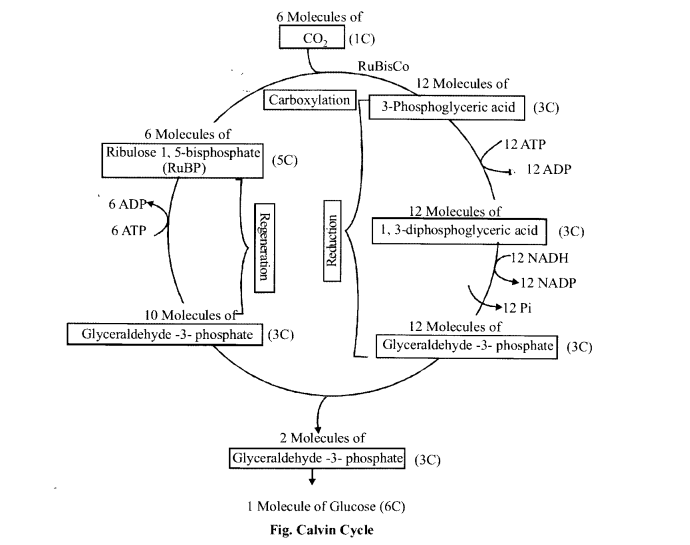
(ii) Reduction
12 molecules of 3-phosphoglyceric acid are converted into 12 molecules of 1, 3 diphosphate-glyceric acid, utilising 12 molecules of ATP and then reduced to 3- phosphoglyceraldehyde making use of 12 molecules of NADPH. Two molecules of phosphoglyceraldehyde react to form one molecule of glucose. It is in this step that there is an actual reduction of carbon dioxide leading to sugar formation.
(iii) Regeneration of RuBP
10 molecules of phosphoglyceraldehyde, by a series of complex enzyme-catalyzed reactions, are converted into six molecules of ribulose 1,5-bisphosphate; six molecules of ATP are needed for this step. This step of ‘ regeneration of RuBP is important for the cycle to continue
We hope the NCERT Solutions for Class 11 Biology at Work Chapter 13 Photosynthesis, helps you. If you have any query regarding NCERT Solutions for Class 11 Biology at Work Chapter 13 Photosynthesis, drop a comment below and we will get back to you at the earliest.